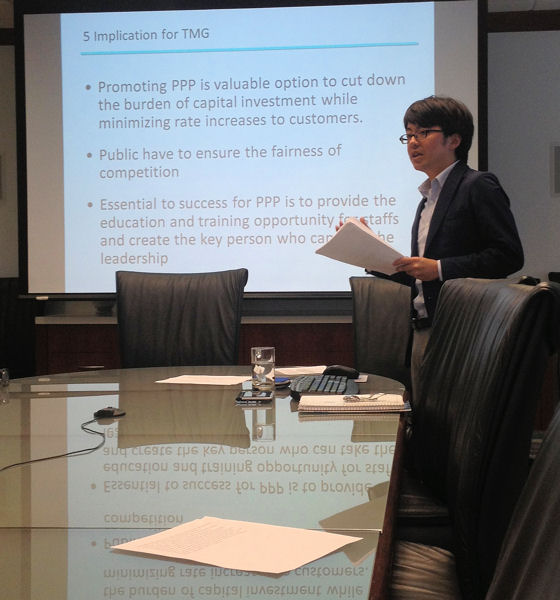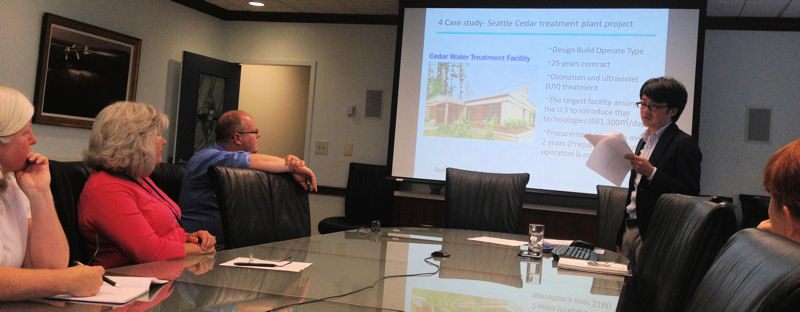
Masaaki Nakayama, team leader in the budget and planning section at Tokyo Municipal Government, Bureau of Waterworks, presents research on public-private partnerships at Water Environment Federation (WEF; Alexandria, Va.) headquarters. WEF photo/Jennifer Fulcher.
On July 9, Masaaki Nakayama’s work at the Water Environment Federation (WEF; Alexandria, Va.) culminated in a presentation on public-private partnerships.
Nakayama, team leader in the budget and planning section at Tokyo Municipal Government, Bureau of Waterworks, spent three months working with Barry Liner, director of WEF’s Water, Science, and Engineering Center, while researching the topic and working on his English language skills at Georgetown University (Washington, D.C.). As a research fellow at the university’s Center for Language and Educational Development and the university’s Public Policy Institute, Nakayama examined the similarities between Tokyo and U.S. water systems to determine lessons each can learn from the other.
“Tokyo Waterworks is one of the biggest water utilities in the world,” Nakayama said. “However we have big challenges.” Challenges include a reduction in the quality of source water, stricter regulations on water quality, and aging infrastructure. These challenges are heightened by declining population, which will result in a decline in income, workforce, and social infrastructure investment, he explained.
“Through researching this topic I’ve recognized that the U.S. water sector faces the same challenges,” Nakayama said. He found that the U.S. shares some of these challenge such as aging water distribution system, increasing water regulation, and increasing financial burden in the future.

Nakayama, research fellow at Georgetown University (Washington, D.C.), spent three months working with Barry Liner, director of WEF’s Water, Science, and Engineering Center, to research public-private partnerships and work on his English language skills. WEF photo/Fulcher.
The U.S. loses 6.4 tillion L (1.7 trillion gal) per year of water from leaks and experiences 240,000 water main breaks each year. Tokyo has experienced similar problems but throughout the years has been able to gradually reduce its leakage ratio to 3% in 2010 by replacing aging infrastructure. Tokyo’s leakage rate is substantially lower than U.S. levels, but the cost to replace U.S. infrastructure is estimated to be $384.2 billion from 2011 to 2030, Nakayama said.
“To overcome this financial burden, U.S. water utilities must try to promote public-private partnerships,” Nakayama said. These partnerships offer an ability to reduce capital investment both in Tokyo and the United States and also offer the ability to “use private sector knowledge,” Nakayama said.
As income declines and costs rise in the water sector, public-private partnerships can provide a new source of income. “Essential for the success of PPPs [public-private partnerships] is to provide the education and training opportunities for staff and to create the key person who can take leadership,” he added.
— Jennifer Fulcher, WEF Highlights








August 29, 2013
Featured